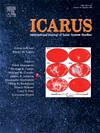用REASON对木卫二快船进行远距离测距和速度测量
IF 2.5
2区 物理与天体物理
Q2 ASTRONOMY & ASTROPHYSICS
引用次数: 0
摘要
美国宇航局木卫二快船任务上的重力和无线电科学(G/RS)仪器的目标之一是提高我们对木卫二星历表的了解,追踪卫星的热轨道演化。在这里,我们提出了一种补充方法,使用欧罗巴评估和探测雷达:海洋到近地表(REASON)仪器,通过跟踪欧罗巴在更远的距离上的回波来增强这些测量,而不是在近距离飞行时进行地下探测的主要作用。我们研究了在海拔超过40000公里的非最低点阶段偶尔进行REASON测量的可能性,以扩展星历表数据集。通过对REASON回波的雷达模拟,我们通过确定地表回波探测的最大高度来评估和演示这种方法,该方法通过在信号往返时间内相干处理数百到数千个脉冲来实现。通过最大化脉冲长度,瞄准木卫二反射最强烈的半球(主要的次木星),并将许多压缩脉冲相加,可以进一步增强接收到的信号的功率。我们还探索了一种相移方法用于速度测量,它使用现有的测距脉冲。利用欧罗巴快船最新的轨道设计,我们确定了与这种方法的最佳工作场景一致的飞越。我们对距离和速度分辨率的性能估计表明,这种方法可以获得与木卫二星历相关的测量结果。这种方法提供了对木卫二轨道演变的关键见解,并最终确定了它的长期可居住性。本文章由计算机程序翻译,如有差异,请以英文原文为准。
Long-distance ranging and velocity measurements by REASON on Europa Clipper
One of the objectives of the Gravity and Radio Science (G/RS) instrument on NASA’s Europa Clipper mission is to improve our knowledge of Europa’s ephemerides, to trace the moon’s thermal-orbital evolution. Here, we present a complementary methodology to use the Radar for Europa Assessment and Sounding: Ocean to Near-surface (REASON) instrument to enhance these measurements by tracking echoes from Europa at greater distances, beyond its primary role of subsurface sounding during close flybys. We investigate the possibility of occasional REASON measurements during the non-nadir phase at altitudes beyond 40,000 km to extend the ephemerides dataset. Through radar simulations of REASON’s echoes, we evaluate and demonstrate this approach by determining the maximum altitude for surface return detection, achieved by coherently processing hundreds to thousands of pulses within the signal’s round-trip time. The received signal’s power can be further enhanced by maximizing pulse length, targeting Europa’s most reflective (leading sub-Jovian) hemisphere, and summing many compressed pulses. We also explore a phase shift approach for velocity measurements, which uses existing ranging pulses. Using Europa Clipper’s most recent trajectory design, we identify flybys that align with the best working scenarios for this approach. Our performance estimates for range and velocity resolution demonstrate that this approach could obtain measurements relevant to Europa’s ephemerides. This method offers key insights into Europa’s orbital evolution and, ultimately, its long-term habitability.
求助全文
通过发布文献求助,成功后即可免费获取论文全文。
去求助
来源期刊

Icarus
地学天文-天文与天体物理
CiteScore
6.30
自引率
18.80%
发文量
356
审稿时长
2-4 weeks
期刊介绍:
Icarus is devoted to the publication of original contributions in the field of Solar System studies. Manuscripts reporting the results of new research - observational, experimental, or theoretical - concerning the astronomy, geology, meteorology, physics, chemistry, biology, and other scientific aspects of our Solar System or extrasolar systems are welcome. The journal generally does not publish papers devoted exclusively to the Sun, the Earth, celestial mechanics, meteoritics, or astrophysics. Icarus does not publish papers that provide "improved" versions of Bode''s law, or other numerical relations, without a sound physical basis. Icarus does not publish meeting announcements or general notices. Reviews, historical papers, and manuscripts describing spacecraft instrumentation may be considered, but only with prior approval of the editor. An entire issue of the journal is occasionally devoted to a single subject, usually arising from a conference on the same topic. The language of publication is English. American or British usage is accepted, but not a mixture of these.
 求助内容:
求助内容: 应助结果提醒方式:
应助结果提醒方式:


